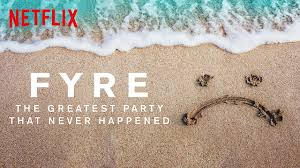Billy in the Fyre: Hulu & Netflix Release Documentaries On Infamous Fyre Festival

Courtesy of Digital Music News

Courtesy of Digital Music News
By Caroline Carr
The Fyre Festival, was advertised as a music festival hosted by Billy McFarland, meant to take place on a Bahamian island in 2017. Both Hulu and Netflix released documentaries emphasizing the gravity of this event and documenting the experience of those victimized by it.
Before the festival took place in 2017, the founder and promoter, McFarland, advertised the event as the “biggest event in a decade.” General admission started at 25,000 dollars, not including: VIP passes, private flights, food, private yacht rides etc. In the promotional advertisement, marketed by Jerry Media, otherwise known as f**jerry, on every social media platform, promised that the festival was going to be an “immersive experience” on a “private and remote island.” The marketing campaign included clips of Kendall Jenner, Bella Hadid, Emily Ratajkowski, and other models and celebrities partying, swimming, and dancing on beautiful beaches in the Bahamas.
The individuals who did not experience this event were unaware of the full story, and thus thought it was funny that customers had paid to be stuck on a remote island. This reaction encouraged pop culture jokes to be spread on social media including references to: the Hunger Games, the Addams Family, and the Lord of the Flies, making this horrifying situation into the next meme trend.
However, the truth is McFarland and many of his associates were complicit in wire fraud, identity theft, bank fraud, and insurance fraud.
One of the documentaries is called Fyre Fraud and was created by Hulu who purposefully released their content four days before their competitors was set to be released. Netflix named their documentary Fyre: The Greatest Party That Never Happened.
The Hulu Documentary opens with asking its viewers to picture people in the twenties sitting on a couch in their parent’s basement wondering what they are going to do with their life. It briefly talks about how the festival happened and the consequences but it focuses on the culture of the festival and the culture of the people who fell victim to it, namely the millennial generation. A Jerry Media employee discussed how it takes less than a second on social media to catch or hook the individual scrolling. Therefore they had athletes, models, and celebrities post a neon orange screen with a link to their promotional video in order to disturb their viewer’s feed and stop them in their tracks. This marketing technique is what made Fyre Festival go viral. Hulu discusses how McFarland manipulated his target audience into engaging in the concept of FOMO or fear of missing out, characterized by a need for visibility.
One of the most controversial aspects of the Hulu Documentary that is different from the documentary made by Netflix is Billy McFarland’s involvement with Hulu. In a questionably ethical decision, they hired the criminal and paid him a few thousand dollars to participate and answer questions in an interview in the documentary.
The first scene of Netflix’s documentary includes a clear blue sky, a beautiful Bahamian beach and the camera transitions to Billy McFarland and athlete Jason Bell promoting the Fyre Festival. These individuals and the images within the first scene of their documentary express the façade that McFarland and his partners used to sell 95% of their tickets within 48 hours as documented by Mick Purzycki.
The main focus of Netflix’s documentary is how the festival took place and the direct consequences it had for every individual involved. The pilot hired by McFarland warned his team about capacity space on the island, health and safety concerns, harsh weather, and mosquitos, asserting that they could not assure the survival of their guests. The pilot’s advice was deliberately ignored and he was soon fired.
Although the team had advertised that the island being used would be Pablo Escobar’s, weeks before the festival they were “kicked off” the island and it became necessary to find an alternative site, an island called the Great Exuma. After these events, a financier named Calvin Wells identified that many of Fyre’s actions were characteristic of fraud. The bands hired to play at the festival were not being paid and the “deserted” island was really a photoshopped picture taken from the Sandals resort. Though Wells tried to inform the public his pleas fell on deaf ears and as a result many customers were traumatized by the event. Additionally, when guests were brought luggage after sundown, people were trampling each other and destroying the few tents that were available.
Andy King, the event coordinator of the Fyre Festival, discussed the guilt he experienced prior to the festival, a direct consequence of the verbal and emotional abuse his employers inflicted on him. King was asked to “take one for the team” by performing a sexual act in order to obtain a main source of water for the festivalgoers and staff. King, already sleep-deprived and emotionally abused for months, said he was prepared to do this after 30 years of a professional career.
Not only were, employees, investors, and customers deceived but also the local Bahamians. Restaurateur Maryann Rolle said“ every soul on the Exuma who could lift a towel [was] working” which meant that she had to feed, staff, and pay many workers who were not being compensated. This resulted in a strike. Desperate for compensation many of the impoverished people threatened to kill members of the Fyre team.
The central aspect of Netflix’s documentary that differed from Hulu’s was that they hired Jerry Media, the marketing company responsible for making the Fyre Festival go viral, to help produce the documentary. Compared to the Hulu documentary, Netflix was also more concerned with the negative experiences of the Bahamians and employees as opposed to the customers.
The end of both documentaries highlights that the only repercussions McFarland faces is six years in federal prison. JaRule, McFarland’s partner, received no repercussions and commented on the failure of the event he said,
“That’s not fraud… that’s false advertising”.
After laying out the evidence of their crimes, the documentary reiterates that compared to both the irreparable emotional and financial damages thousands faced, their punishments did not fit the crime.

Courtesy of Capital FM







